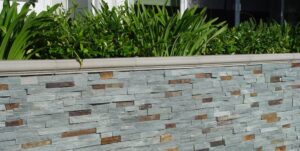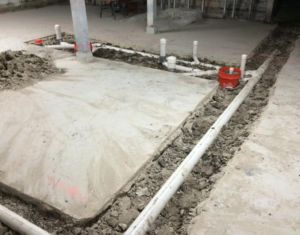Concrete Stone Facing is a popular choice for homes. It’s durable and comes in four different styles with over 30 colors to choose from.

Moisture will get past your stone veneer application and into the sheathing of the house, so it’s important that you have a game plan for moisture management. That includes a drainage mat or furring strips mounted to the sheathing.
Manufactured stone veneer is an increasingly popular way to add the look of natural stone to a building. Like any remodeling project, the success of a stone veneer installation is determined by careful preparation. Whether it’s concrete or cement board, there are several key steps that must be taken to ensure the final product performs as intended.
The first step in preparing the substrate is to wash away any dirt or oil residue from the wall surface. This helps to ensure a consistent color and texture of the finished product. It also removes any preservative chemicals that might have been added to the material to help extend its life and durability.
Once the wall is clean, a scratch coat of mortar should be applied. This can be mixed from scratch using a standard mix of one part type N or type S cement and 2.25 parts sand, or purchased as premixed scratch coat mortar. If using a premixed scratch coat, follow the manufacturer’s recommendations for application.
It is critical that the scratch coat is completely dry before applying the stone veneer. This helps to prevent moisture penetration that can lead to Efflorescence. Efflorescence is a white residue that forms when cementitious materials such as brick, CMU block, concrete, or thinset are exposed to moisture for extended periods of time. This can result in the release of volatile compounds that crystallize and leave a salt-like deposit on the face of the product.
When working with real stone veneer, it is also important to stagger the pieces. This prevents them from lining up and forming unsightly grout lines when the product is grouted. It is also a good idea to use a light colored mortar so that the joints are less noticeable.
Once all of the pieces are installed and have had a chance to set for 24 hours, a final joint finish should be applied with a pointing tool or a damp sponge. This helps to prevent moisture penetration and protects the stone from damage and stains.
In exterior applications, it is also a good idea to apply a waterproofing sealer. This will further enhance the longevity and beauty of the stone and help to minimize future maintenance needs.
Mixing
Stone masons have long relied on a mix of sand and other aggregate, cement (typically Portland cement) and chemical admixtures to create a strong and durable concrete structure. However, this process is laborious, time consuming and requires the use of hand tools. A revolutionary new adhesive has been developed that eliminates the need for mortar and greatly simplifies the process. This heavy-duty adhesive has proven to be extremely effective and is now the adhesive of choice for many professional masons.
Before applying the adhesive, it is important that all surfaces are free of dirt, waterproofing, paint, form oil and any other substance that could inhibit a strong bond. A rough texture is also necessary to ensure a good adhesion of the adhesive. The surface should have a minimum ICRI (International Concrete Repair Institute) rating of 2.
In order to make the process even easier, the contractor should use a type of mortar that is pre-mixed and ready for application. This is usually available at brick/masonry supply yards (where the pros buy their materials) and should be mixed according to the manufacturers instructions. The mixture should be like peanut butter consistency so that it can easily be spread with a masonry trowel.
If the masonry veneer is to be used for exterior applications, it is a good idea to apply a moisture barrier such as a peel and stick membrane or #30 felt paper to prevent any water penetration into the wall. This can be done before laying the veneer or after it has been installed. In either case, the moisture barrier will help to protect the stone from mold and mildew growth.
For new block or poured walls, the mason should make sure that the wall is plumb before attempting to lay the stone veneer. This will save both time and effort, as well as ensuring that the stones are set properly.
For existing block, poured or wood-frame walls, the mason should make sure that there is adequate support under the stone and that the wall is attached to the foundation with the proper wall ties. This is especially important when working with older walls, which may have shifted or settled over the years.
Pouring
Concrete stone veneer is a growing popular building material that gives homes and commercial structures a rich, upscale look. It is often installed over a concrete masonry or wood frame wall and a variety of construction methods are used. The success of a stone veneer system depends on proper installation and inspection. This TEK addresses key installation/inspection points to ensure an effective, long-lasting stone veneer system.
Manufactured stone veneer is fabricated by pouring a lightweight concrete mix into rubber forms of different styles and then using a coloring process to make the finished product resemble real stone. It is a less expensive alternative to natural stone and can be installed by the professional or do-it-yourselfer. It is important to keep in mind that manufactured stone is not as durable as natural rock and can be affected by moisture. It is a good idea to treat the stone with a silane-based, non-film-forming, breather-type masonry sealer. This will help extend the life of the stone, especially if it is located in moisture-prone areas like walls near swimming pools or hot tubs.
Roger starts his work on a clean concrete wall (any painted or stuccoed concrete must be stripped and roughed up with a power chipping hammer first) but stone veneer can also be applied over cement board or even directly to wood sheathing. Whatever substrate is chosen, it must be covered with a weather resistant barrier, galvanized metal lath and a half inch scratch coat before applying the stone veneer.
The next step is to bolt down a steel angle iron to the wall and then create a brick ledge to set the stones on. Using a level and a mason’s chisel, Roger sets the stones in an alternating pattern along the ledge. When the first row is complete, he ties in the inside corners with a piece of rebar. Roger then mortars the stones to the wall with a Type S mortar.
After 5-6 hours when the mortar has completely cured, Roger can begin laying his stone facing over the rest of the walls. He makes sure to check that the walls are plumb as he goes, this speeds up the installation and helps to avoid problems later. A mason’s hammer is also used to smooth the edges of the stones and make them fit together better.
Finishing
After the concrete is poured and rough floated, step away from your project for a day or two to allow it to cure. The surface of your concrete will dry and harden and this is the ideal environment for your stone veneer to begin bonding with it. Moisture control is the key to any stone installation. You will need a moisture barrier over your substrate (cement board, brick, or cast-in-place concrete), flashing around doors and windows, and gutters to direct water away from your stone application, not into it.
During the curing process, chemical admixtures in the concrete react with water to form strong bonds between the aggregate and other concrete elements. These chemical reactions create a strong material that is very durable and durable against impact. The water is also a natural de-icer, protecting the stone from cold temperatures and snow.
Before you begin installing the stone, a “dry layout” is recommended to determine how your design will work out and whether any adjustments need to be made. It is particularly important to verify that the wall is plumb so that you can lay the stone evenly. A level is the best tool for this.
If your concrete is going to be exposed to the weather, it should also be protected with a waterproofing membrane to prevent damage caused by rain water and sun exposure. This is especially true in wet climates.
Once you have a clear understanding of your layout, it is time to start applying the mortar. Be sure to use a masonry type mortar that has been specifically designed for your stone veneer application. Using the proper mortar will ensure long life and the proper strength to support your stone.
When using mortar, it is very important to scratch out any excess prior to laying your stones. Scratch-ing too early can smear cement on the edges of your stones and compromise the integral structure that is hidden within the mortar bed. This is why it is important to wait.
It is also a good idea to use a trowel with a fine point and to try to keep the joint widths consistent throughout your project. This will help to create a uniform appearance that is more pleasing to the eye.
